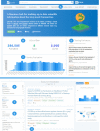LitCovid in 2022: an information resource for the COVID-19 literature
- PMID: 36350613
- PMCID: PMC9825538
- DOI: 10.1093/nar/gkac1005
LitCovid in 2022: an information resource for the COVID-19 literature
Erratum in
-
Correction to 'LitCovid in 2022: an information resource for the COVID-19 literature'.Nucleic Acids Res. 2023 Jan 11;51(1):500. doi: 10.1093/nar/gkac1243. Nucleic Acids Res. 2023. PMID: 36537196 Free PMC article. No abstract available.
Abstract
LitCovid (https://www.ncbi.nlm.nih.gov/research/coronavirus/)-first launched in February 2020-is a first-of-its-kind literature hub for tracking up-to-date published research on COVID-19. The number of articles in LitCovid has increased from 55 000 to ∼300 000 over the past 2.5 years, with a consistent growth rate of ∼10 000 articles per month. In addition to the rapid literature growth, the COVID-19 pandemic has evolved dramatically. For instance, the Omicron variant has now accounted for over 98% of new infections in the United States. In response to the continuing evolution of the COVID-19 pandemic, this article describes significant updates to LitCovid over the last 2 years. First, we introduced the long Covid collection consisting of the articles on COVID-19 survivors experiencing ongoing multisystemic symptoms, including respiratory issues, cardiovascular disease, cognitive impairment, and profound fatigue. Second, we provided new annotations on the latest COVID-19 strains and vaccines mentioned in the literature. Third, we improved several existing features with more accurate machine learning algorithms for annotating topics and classifying articles relevant to COVID-19. LitCovid has been widely used with millions of accesses by users worldwide on various information needs and continues to play a critical role in collecting, curating and standardizing the latest knowledge on the COVID-19 literature.
Published by Oxford University Press on behalf of Nucleic Acids Research 2022.
Figures




References
-
- Chen Q., Leaman R., Allot A., Luo L., Wei C.-H., Yan S., Lu Z.. Artificial intelligence in action: addressing the COVID-19 pandemic with natural language processing. Annu. Rev. Biomed. Data Sci. 2021; 4:313–339. - PubMed
-
- Chen Q., Allot A., Lu Z.. Keep up with the latest coronavirus research. Nature. 2020; 579:193–193. - PubMed
Publication types
MeSH terms
Supplementary concepts
LinkOut - more resources
Full Text Sources
Medical
Miscellaneous

